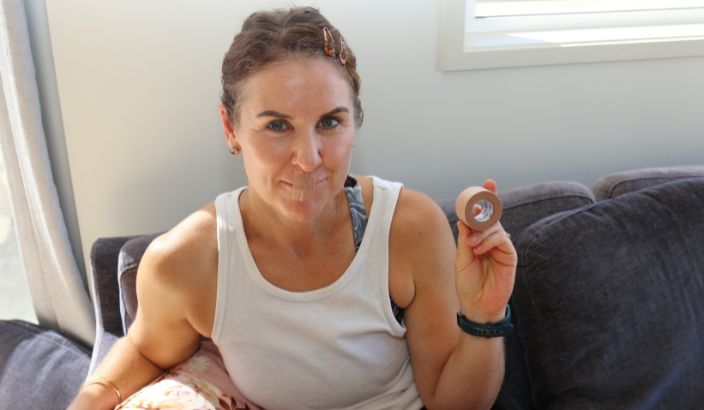The rise and risks of mouth taping

Emma Kain with the skin-coloured mouth tape that has helped her achieve a more restful night's sleep. Photo: Eloise Martyn.
A Richmond woman, who once “sounded like Darth Vader” when she slept, now says she could never go back to not taping her mouth at night, but health professionals warn there could be risks.
Emma Kain tried mouth taping - a health practice which involves placing an adhesive strip over your mouth while you sleep at night - after hearing her sister rave about it, and she saw a drastic change.
“I used to wake up with a dry throat, needing water and would end up in a cycle of constantly getting up. My lips were always very dry, too,” Emma shares.
She says the discomfort reached a point where she couldn’t ignore it any longer.
“I was just so over it, so I decided to try mouth taping.”
That decision, made three months ago, quickly turned into a game-changer.
Mouth-taping, in theory, is supposed to encourage nasal breathing and improve your sleep health, helping everything from allergies and respiratory conditions to dry mouths and sleep apnea.
“The first night I taped my mouth, I didn’t wake up with the dry horrors. Three nights later, my dry lips were completely gone,” Emma says.
Breathing Clinic Nelson breathing educator and associate Buteyko practitioner, Nicky McLeod says, for the average person sleep taping can be helpful, but warns there are risks involved.
“There are some potential unattended side-effects, it’s a bit risky to just suddenly force four times more air through your nose, you can wake up with panic attacks, or put too much strain on the left side of your heart.”
She says that if people are breathing through their mouth at night, they have dysfunctional breathing which happens in the daytime too, so should seek assistance to help change it.
“In eight years of clinical practice, I have observed that how you breathe at night mirrors how you breathe during the day. Breathing retraining addresses all aspects of the breathing pattern (rate, route, rhythm, volume and locale) for all situations (awake, asleep, at rest, while exercising and while talking). When applied correctly this will in most cases restore a functional breathing pattern with nasal breathing at night.
“This idea has been taken from the Buteyko Method and is being used out of context with little understanding of the breathing retraining process, of where taping is indicated, contraindications and of the possible unintended negative consequences of forcing nasal breathing,” Nicky says.
While Emma’s personal experience has been overwhelmingly positive, medical evidence on mouth taping is still limited.
There haven’t been enough scientific studies to fully confirm the benefits or determine how often you should do it. However, the theory behind mouth taping is that by keeping your mouth closed while sleeping you’re forced to breathe through your nose.
Nasal breathing offers several benefits over mouth breathing, including temperature control, filtering allergens, dust, and toxins, as well as keeping the throat and mouth moist to prevent dryness.
Emma, who once “sounded like Darth Vader” when she slept, now enjoys quieter, more restful nights.
“I could never go back to not mouth taping,” she says.
